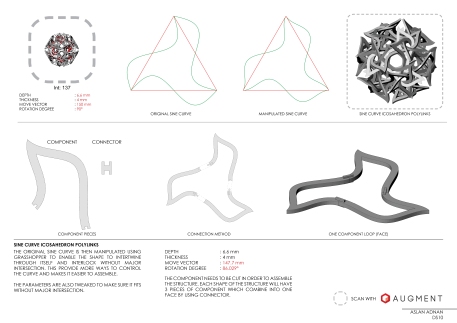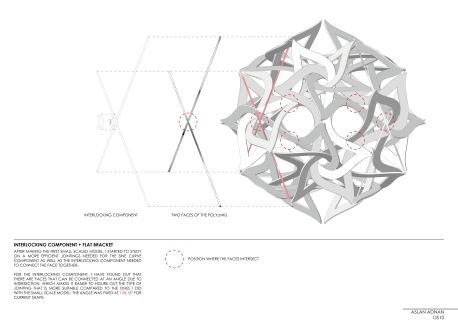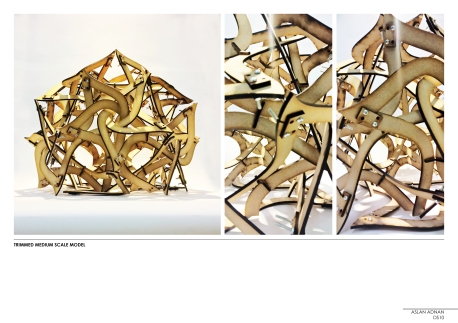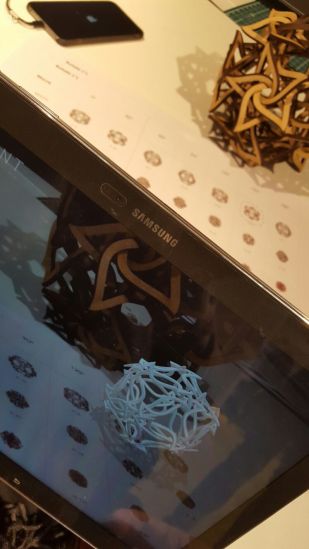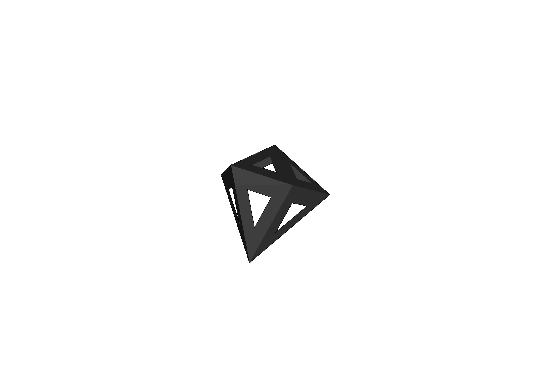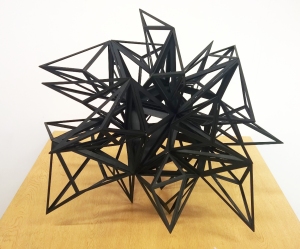In the 1970s and 1980s Alan Holden described symmetric arrangements of linked polygons which he called regular polylinks or orderly tangle. The fundamental geometric idea of symmetrically rotating and translating the faces of a platonic solid is applicable to both sculpture and puzzles.
The process started with making a frame out of the geometry; in this case a cube. All 6 faces are moved inwards with the central point of the original cube is used as the origin axis.
Using the same origin, the faces of the geometry are then rotated along their axis at a certain degree to create the orderly tangle.
The faces are then thicken to ensure all of them fixed together.
Using the method as stated before, an icosahedron is used and different length of movement and degree of rotation is used to suit the shape.
—————————————————————–
Some images can be scanned using augmented reality apps called Augment.
Links to Augment apps:
iOS: https://itunes.apple.com/us/app/augment/id506463171
Android: https://play.google.com/store/apps/details?id=com.ar.augment
—————————————————————–
In this experiment, the edges of the icosahedron is replaced with sine curve.
In this experiment, the edges of the icosahedron is replaced with triangular curve.
In this experiment, the edges of the icosahedron is replaced with steps curve.
——————————————————–
The icosahedron sine curve edges is used to continue with further design. The original sine curve is manipulated using grasshopper to enable the shape to intertwine through itself and interlock without major intersection. This provide more ways to control the curve and makes it easier to assemble.
A small model is built to see how it holds together.
——————————————————–
After making the first small scaled model, i started to study on a more efficient jointings needed for the sine curve component as well as the interlocking component needed to connect the face together.
A medium sized model is built with the new jointing design.
——————————————————–
The sine curve polylinks created an icosahedron space on the inside. Each triangle face of the icosahedron corresponds to the sine curve geometry due to the initial process of replacing all the edges with sine curves.
In icosahedron, there is always surface that pairs in a parallel to each other, in this case 10 pairs of the 20 triangle faces. Based on this, i tried to use the surface as a floor plate for the structure. The whole geomtery is rotated so that one of the surface lays flat on the ground. The excess part is then removed.
The section shows the space inside with one of the triangle face acts as a floor plate.
—————————- EXPERIMENTS —————————-
Different experiments were carried out using the system as the basis for design. The experiments focus more on a different form other than the spherical nature of the system.
In this experiment, the polylinks is divided into two halves (each half contains 10 modular shape) and the bottom half is move to the side on the x- axis while still intertwine with the top half portion. Due to the adjustment, the bottom half is also slightly moved up on the z-axis to ensure no major intersection. This creates a more elongated structure with the system still intact. The process is repeated with each time the geometry still intertwine between the top and bottom half.The process is then repeated along the y-axis to create a planar design based on the shape.
——————————————————–
In this experiment, the polylinks is divided into two halves (each half contains 10 modular shape) and the bottom half is removed. The top half contains two component face that is in the same plane but different angle. These two will be used as a sharing planes to array the whole structure. The top half structure is then copied to the adjacent with the parallel face is lined up. The structures will intertwine at the sharing planes helping it to stay in place. The process is repeated with each time the geometry still intertwine at the sharing planes on each iteration.
——————————————————–
In this experiment, using one of the component face as a floor plate, the structure is rotated to lay the component face on the floor and all the excess (bottom) are removed. The opposite component face, which is in parallel to the one used as floor plate, will be used as the second floor plate. All the excess (top) are removed as well. The structure is then mirrored along the x and y plane to get a tower shape structure. The trimmed part where the excess are removed will connect with the new mirrored structure making them all connected.
—————————- BURNING MAN PROPOSAL —————————-
Desert Petal









